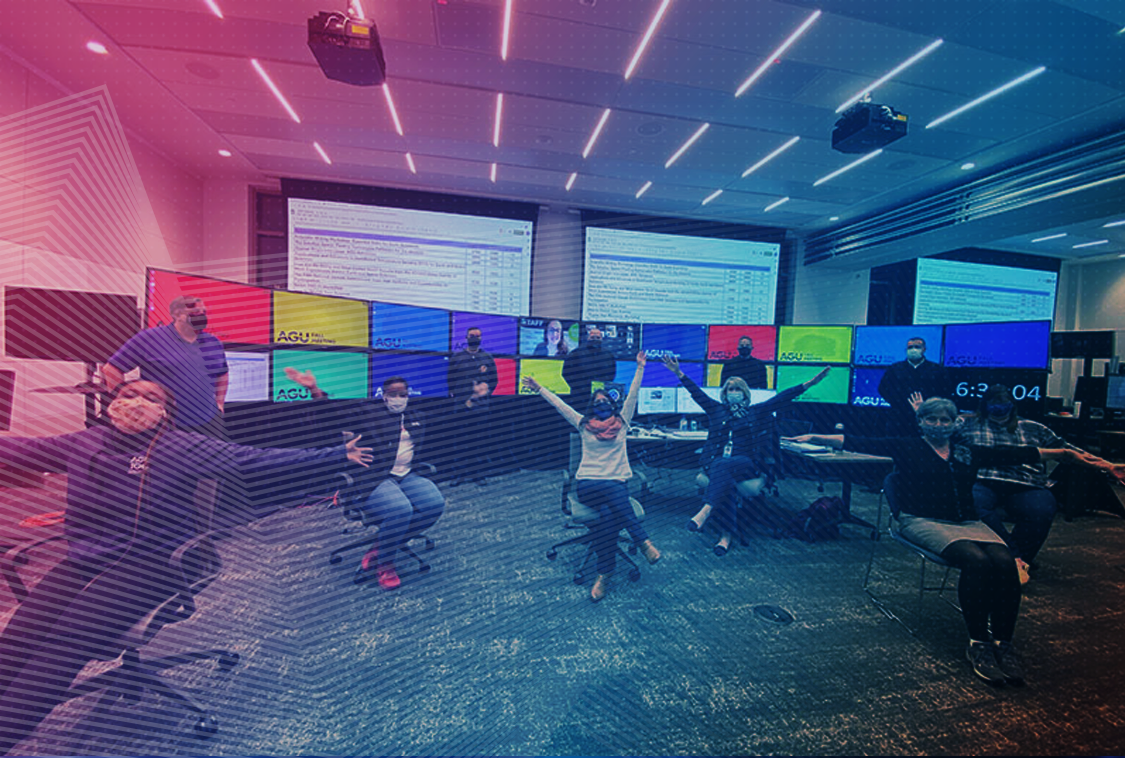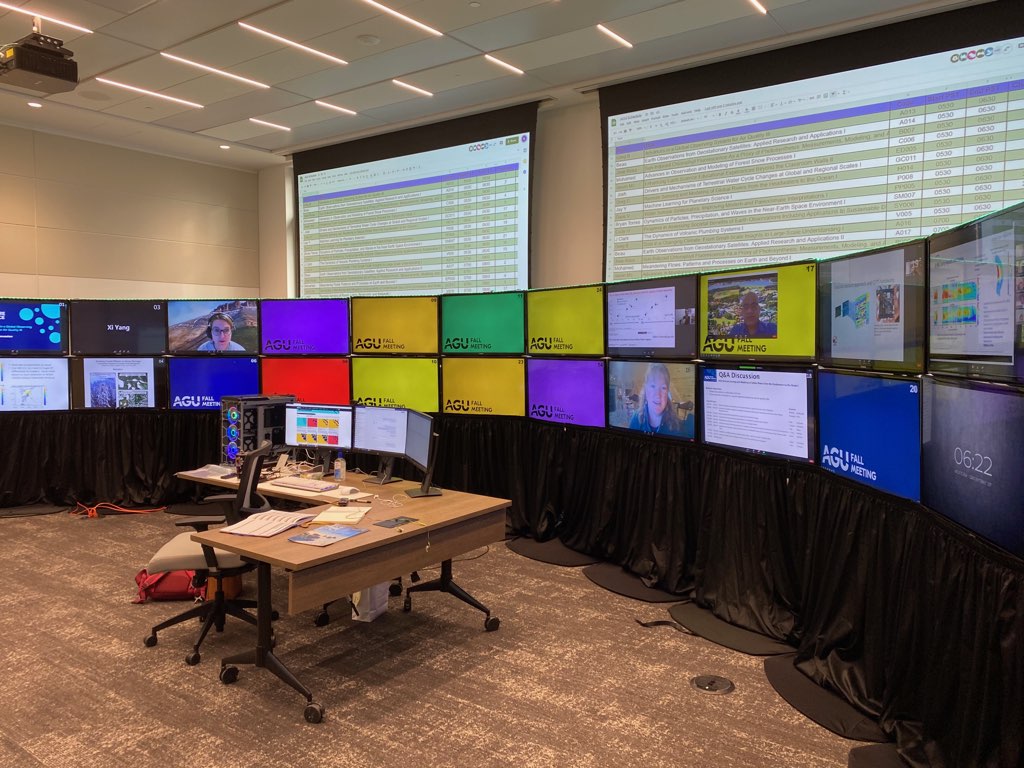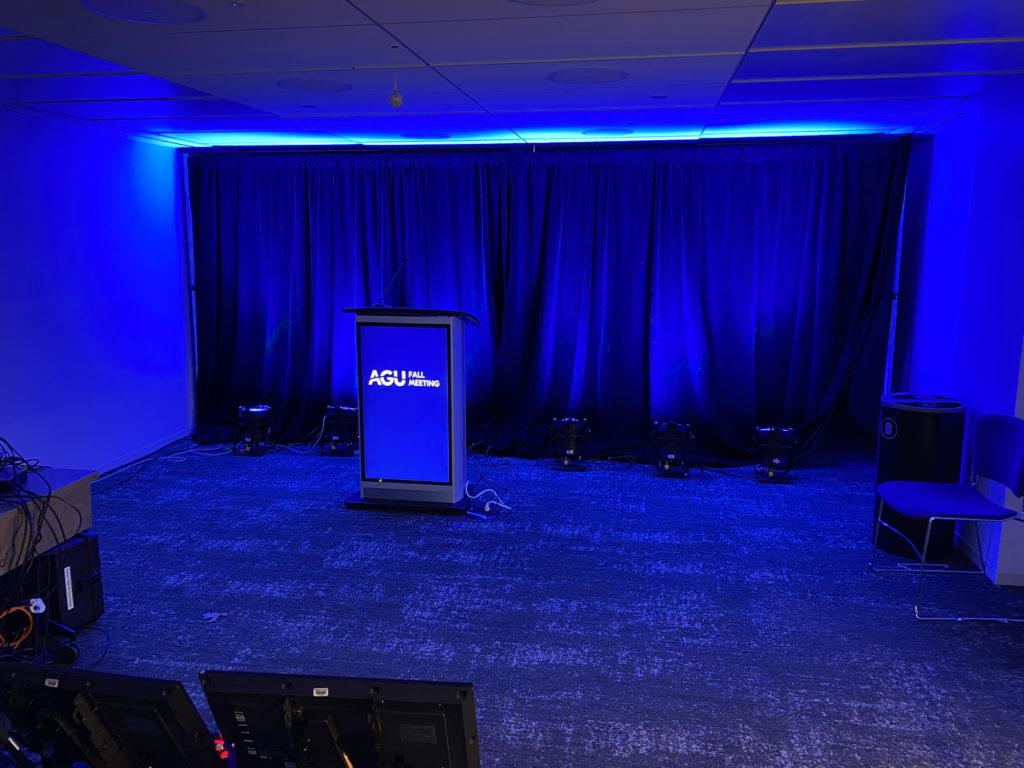
Each year, the American Geophysical Union’s (AGU) annual meeting draws more than 20,000 people from around the world to share information, collaborate with colleagues, network and learn about advances in earth and space science. And, there is a lot of information to present; over the usual five-day meeting, there are more than 10,000 individual presentations delivered each year.
So, as we started planning the fully virtual Fall 2020 meeting, the team had to get creative about how to design and execute an exceptional and flawless attendee experience that supported such a content-heavy agenda.
A quick snapshot of the meeting:
- 13 show days, each running non-stop from 4:30am-12:30am PT
- 1,000 semi-live sessions
- 10,000+ pre-recordings
- 27,000 attendees
- 26 producers + floating production supervisors
To execute a meeting of this scale, we leaned on established virtual best practices, such as pre-recording a majority of the sessions, as well as added new ones, like building a physical command center for the planning and production team.
A socially-distanced command center provided a 360-degree meeting view
For a meeting planner, those moments before a virtual session or keynote kicks off – sitting in your home/office behind your own computer screen – can be brutal. The production crew available via phone and chat channels, you hold your breath while you wait to make sure the meeting goes off without a hitch.
Now, multiply that by 26 sessions kicking off at the same time.
The AGU team was looking for a different, more hands-on strategy to ensure the seamless delivery of the attendee experience, and a more streamlined process for troubleshooting. The result was incredible. Together, we designed a socially-distanced command center that would safely allow for members of the production (Projection) and planning (AGU) teams to see and hear every single session taking place at any time, communicate with the team in charge of each, and identify any problems in real time so we could address them immediately.
The result was incredible. Together, we designed a socially-distanced command center that would safely allow for members of the production (Projection) and planning (AGU) teams to see and hear every single session taking place at any time, communicate with the team in charge of each, and identify any problems in real time so we could address them immediately.
Over the course of 13 days, 11 people worked side-by-side (well, with 10 feet in between), each with a headset that enabled listening to any of the sessions taking place – up to 26 channels – and all in a position to see the 24-screen viewing center that streamed content as it was presented. (The rest of the production team executed the meeting remotely from their home studios.)
A solid back-up plan meant the attendee experience remained seamless
Like any meeting, be it in person or virtual, having a solid plan for when things go wrong is crucial for maintaining a positive attendee experience – and that was no different for AGU’s virtual event. First, we built a separate virtual studio for high-profile live broadcasts should AGU executives need to deliver messages throughout the meeting. While we did not end up needing it, it was good to know we had access to a place – within steps of the command center – where we could quickly produce a high-quality address.
First, we built a separate virtual studio for high-profile live broadcasts should AGU executives need to deliver messages throughout the meeting. While we did not end up needing it, it was good to know we had access to a place – within steps of the command center – where we could quickly produce a high-quality address.
Second, we had a backup studio and producer ready should anything go wrong with the delivery of the live keynote sessions being run by the platform provider.
On the third day, we ended up having to switch over due to some cross-audio issues for the live sessions. (We had this same producer help with the pre-recordings, so he was familiar with the client, speakers and flow of the show.)
Third, the entire planning team had access to each session 30 minutes prior to it going “live” in the platform. That allowed for us all – including the AGU team – to make sure the presenter was ready, the tech was working, and the session was prepped to begin without a hitch. In case of an issue, we had a Zoom meeting with all the producers going, so we could simply ask them why something looked a certain way or why something seemed to be an issue. This enabled us to quickly fix any problem within minutes, before it became part of the attendee experience.
An organized and well-executed process for pre-recorded content was critical
Our team was charged with managing the 1,000 “live” sessions, which were made up of pre-recorded presentations or talks followed by a live Q&A with the speaker. With that much content, it was necessary that we had a process to schedule, prepare, record, edit and produce. And, with only one month to do it all, that process had to be flawless.
We set up an upload site with a scheduler built into it that managed all of the presenters. Preparation is always key, so we scheduled two full-day Zoom meetings where the moderator of each session could join and talk through the flow. It was from these meetings that we created the run of show – what would happen every minute for each one of the live sessions.
In the end, there were a few presenters who couldn’t get a recording done by the deadline, so we moved them over to a fully live session, and prepared them accordingly.
Each year, the annual AGU meeting is a feat of organization, teamwork and management. While virtual, this year’s event was no different; we simply needed to execute those things in a new way. While it serves as a fabulous case study for how to design, produce and execute a successful virtual event, it also can be used as a template for how to start bringing in-person events back safely – starting with the meetings and production teams. Working physically together, we were able to share that heart-racing experience of gearing up and watching an event go live, and celebrate as the last attendee logged off.
I can confidently say there’s absolutely no replacing that.
Lauren Parr, AGU’s vice president of meetings:
“I simply couldn’t imagine sitting in my living room watching the event from my laptop, holding my breath while every session over 13 days streamed. We had planned and prepared, mapped out every session and identified every contingency, but there were still the unknowns – people’s Internet connections, scheduling snafus. Having the entire team together – and the ability to see and hear the entire event as it went live was a game changer. For me, this is the way to do a virtual meeting.”
“Projection’s vision to design the command center made the meeting come alive for our team, which was so important after all the work we put into making it happen. I am always amazed at the Projection team’s execution, work ethic and creativity, but this took that to a new level.”

One Comment